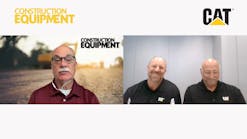Astec has its Trencor line covering the large end of the trencher offering, topped off by the industry’s largest model, the 450,000-pound, 1,200-horsepower T1860. Indeed, the Astec product covers the largest range.
But if there’s a single brand name that comes closest to running the gamut of the trencher offering, it’s Vermeer, from the smallest gas-powered walk-behind to the 600-horsepower T1255 Commander 3. And while the 120-horsepower quad-track RTX1250 was garnering attention over the past year, the company was introducing an innovative new model at the larger end, too.
For the T1155 Commander 3, Vermeer co-developed with Rotary Power a 16-liter headshaft motor that eliminates the need for two trencher motors. The resulting location of the cab between the cross conveyor and trencher attachment emulates the styling on Vermeer’s smaller Commander 3 trenchers.
“We have one larger model, the 1255, on which we had to put the cab behind the cross conveyor, which restricts visibility somewhat,” says Dean Whitten, solutions specialist with Vermeer. “We wanted to get back to what the customers really love, that being the visibility to the trench from having that cab in between the working unit and the conveyor of the spoil. By doing so, we needed to develop one big motor, so that we could put one large motor on one side of the head shaft and not have two like the 1255 has — a 10-liter on each side.”
As standard, the 540-horsepower T1155 Commander 3 comes wired to accept telemetrics to monitor engine hours and location, as well as laser and GPS systems for machine control. The latter, says Whitten, is becoming a bigger customer want in both the sewer market and, when the machine adds a terrain leveler attachment, the mining industry.
As a new product offering, the T1155 Commander 3 is dependent upon shifting needs of established users of both smaller and larger models, says Whitten.
“The reaction is like any new machine: It’s always slow starting when you’re throwing another model into the mix,” he says. “People who have 1055s are looking at this very strongly because they may want a little larger machine, but their 1055s are still in very good shape or almost new — in that three- or four-year timeframe — and you have to wait on trade cycles. We understand that.”
By comparison, says Whitten, it’s not a matter of replacing machines for current T1255 Commander 3 customers, but rather considering adding the T1155 Commander 3 as an easier-transported complementary piece to work on slightly smaller projects.
For Ditch Witch, the innovations continue as the product line grows. The HT220 features a flywheel gearbox that delivers horsepower to the attachment on demand while protecting the hydraulic system from shock.
“Most of these units are designed to dig in rock, and when you have rock, you have a lot of dynamic shock load going back to the headshaft,” says Adkins. “By having the flywheel effect there, whenever you have these shock loads, that keeps the shock from going back into the hydraulic and drive system itself. It allows the flywheel to take most of that abuse.
“You’re in dirt and all of a sudden you encounter some rock: If you actually watch your chain, you’ll see it can stall very briefly, and the horsepower of the engine has to overcome that initial shock. What the flywheel does on there is allow that increase of horsepower to almost be instantaneous to the headshaft, so there’s no stalling of the chain.”
As for the consideration of models sized beyond the soon-to-arrive HT300, the availability of services throughout the Ditch Witch dealer network will have a lot to do with that, says Adkins. “We have to grow it at a rate where our dealers can support the equipment.
“I like to see our line growing,” he says. “At what rate? Our main emphasis is making sure that we can develop a product and still support the customer. We can build whatever we want, but if we can’t support the customer, we’re not doing him a favor.”
And the news of the day isn’t all bad, agrees a competitor who’s lived through more than his share of cycles.
“Many utility companies have a five-year plan, just like everybody else does,” says Astec’s Wren, “and there’s a lot of service work, maintenance work and replacement work outthere . . . even with the downturn in housing.”
PREVIOUS PAGE1 | 2



